Different Types Of Audio Products For Your Studio
I’ve been finishing the preparations to open my new audio studio lately, and I must say I’m amazed by how much it’s been done to get to this point. In the beginning, I really thought it would take me only a few days to get and set up everything and start recording, but what it really took me was about a month and a half! The computer, the mixing board, the microphones and all the cables…I had to visit at least three different stores for audio products Australia wide. Of course, I didn’t wander from one place to another with the list of things in my hand, but I did my scavenger hunt online; the Internet is a true friend when you’re on a budget and in a hurry to start a project.
Surprisingly, what took me a few days to choose were the cables and connectors for the various elements for my studio. Can you believe there are so many different types of cables and connectors in the audio products Australia stores? After doing an exhausting research of what seemed to be a palette of cables, I managed to classify the most important products according to few factors:
Balanced and unbalanced audio cables
The basic difference is in the rejection of interference; balanced cables reject interference a lot more than unbalanced. Balanced audio cables do this by twisting together two identical conductors and then surrounding them with a shield. This shield keeps any voice that interferes with the sound signal to be picked on the way, so the sound that gets on the ground is completely clean. Unbalanced audio cables on the other hand, use only one unprotected conductor and therefore, do not prevent interference. So, if there’s any other noise coming along with the audio sound, you’re going to hear it. You don’t want that in a recording studio.
Audio connectors
From this large category, it’s my personal opinion that you need just a few important ones:
- XLR connectors come with three pins and they offer a balanced connection. I got this cable for connecting a microphone on a mixing board. Mine is a Cannon XL, and the R was added afterwards and stands for the rubber compound of the cable.
- RCA are also known as phono connectors and these are unbalanced mono connectors. As such, they can be used for both analogue and digital audio connection.
Digital Audio cables/connectors
Another large category of audio cables and connectors. From this category, those that will do you most good are:TDIFs or Tascam Digital Interconnect Interface. This is a 25-pin D-sub connector for an unbalanced connection. As such, this cable can send up to 8 channels of digital audio in both directions, so two separate cables for receiving and sending aren’t necessary.
- TDIFs or Tascam Digital Interconnect Interface. This is a 25-pin D-sub connector for an unbalanced connection. As such, this cable can send up to 8 channels of digital audio in both directions, so two separate cables for receiving and sending aren’t necessary.ADAT Lightpipe – ADAT or Alessis Digital Audio Tape. This is a more sophisticated cable than the rest on the market, since it uses a fibre optic cable to transmit the 8 channels of audio in digital format. Plus, these cables come with Toslink connectors on both ends.
- ADAT Lightpipe – ADAT or Alessis Digital Audio Tape. This is a more sophisticated cable than the rest on the market, since it uses a fibre optic cable to transmit the 8 channels of audio in digital format. Plus, these cables come with Toslink connectors on both ends.
Bottom line is, you need good, quality cables and connectors if you want the best audio experience in your recording studio. You can use a mixture of all the above mentioned, but have in mind that digital audio cables and connectors are rarely used in a recording studio, because the recorded sound goes on a hard drive instead of a specialist multitrack recorder.

